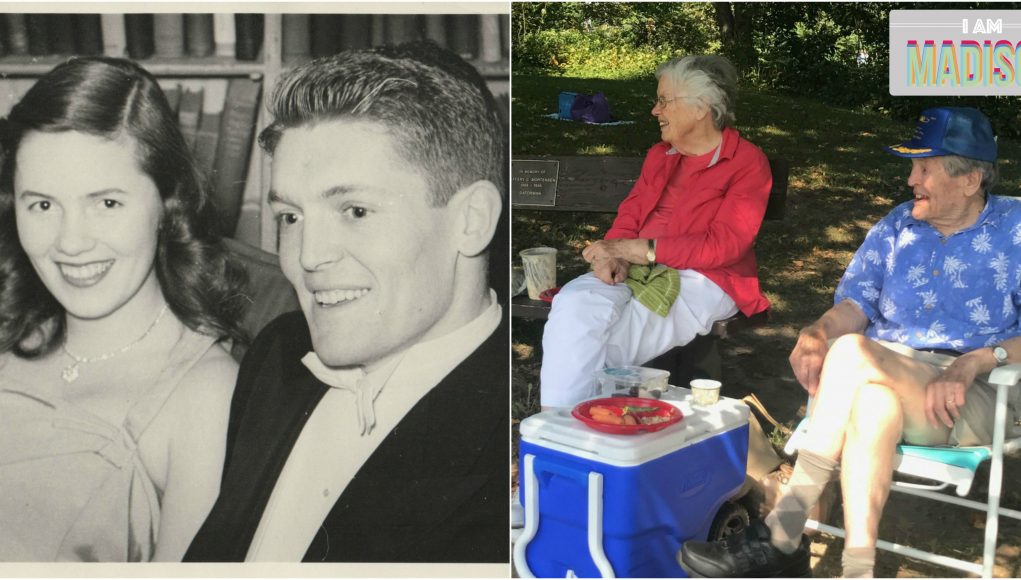 Bob Hastings returned from World War II to attend UW Madison, and it didn’t take long before he wasn’t attending alone.
Bob Hastings returned from World War II to attend UW Madison, and it didn’t take long before he wasn’t attending alone.
“I met this beautiful woman and I decided to talk to her, and didn’t let anyone else talk to her” Bob says.
At that time, UW-Madison wanted all cafeteria employees to have Sundays off of work so people could go to church or be with their families, so Sunday became Bob and Jean’s night to eat out. Bob recalls picking Jean us just along State or South Park street. Most Sundays night they went to The Plaza on Gilman Street for a burger. During special occasions, they took a cab out to Cuba Club on University Avenue, which was new at the time (and which closed in 1988). Maybe afterwards Bob and Jean and their friends would head down to go watch a movie at Capitol Theater (which is now a part of Overture Center).

Life on campus was different then, especially with the influx of veteran soldiers coming in after World War II. With the recent passage of the GI Bill, many soldiers decided to take the opportunity it offered.
“I didn’t even have to pay for a pencil,” says Bob.
Due to the rapid influx of students attending UW Madison, many classes were held at strange places because the school was not prepared for that many students. The university built many quonset huts for classes, and even the buildings such as the Congressional Church lent space.
In the 1940’s, students attending UW Madison were mostly of Caucasian descent. The oldest buildings at the time were North and South Hall, then Bascom Hall, and more buildings were constructed later during the 1950s and 1960s.
 Many students struggled to sign up for classes, especially since it was all done on paper. If a class was filled up by the time the student reached the front of the line, they would have to go to the back of another line and wait to sign up for a different class.
Many students struggled to sign up for classes, especially since it was all done on paper. If a class was filled up by the time the student reached the front of the line, they would have to go to the back of another line and wait to sign up for a different class.
Bob and Jean remember women being required to live either in a supervised dorm with a housemother, or in a sorority with a curfew of 10:30. Jean recalls a friend who stayed out late and did not come home, and she was kicked out of school for disobeying the curfew.
The community around campus was quite different then, as well. Downtown around the Square were almost all clothing stores, such as Manchester’s. At that time there was no Westgate or Hilldale Mall, so State Street was where most shopped for their clothing. Clothing stores were more formal, as men wore suits and ties and women wore dresses. People got fitted and waited on by salespeople.
The University dress code had men wearing dress pants (slacks) and shirts without brand names or images due to it being a distraction to other students. Only shirts with stripes or solid colors were acceptable. Only twenty years later the atmosphere started to change.
During the late 1960’s and 70’s protests became more violent than past decades.
“There was a big difference in the generations,” says Heidi Hastings, Bob and Jean’s daughter, now a teacher at Madison West. “In Bob’s situations if you got called in the service and you would not question authorities. During the Vietnam war, which turned out (to be) a bad idea, we had government officials that were lying to us, covering up what we were doing, like bombing and killing civilians. College and high school students were wondering why, and the older generations would not question it so it caused friction.”
Vietnam War protests affected the campus, even causing classes to be cancelled. During the height of the tensions in 1967, The National Guard erected a large steel fence, so the protesters wouldn’t be able to throw rocks. Government officials were unsure how to de-escalate situations like these, so the police used tear gas for the rioters.
“At West Junior High, I had a friend who lived on Langdon Street because her parents managed one of the private dorms. She couldn’t come to school for a couple days because of the tear gas. It was in the lobby and hallways so she stayed locked at home,” says Heidi.
Following the violent protests at UW, high school students caught on and began protesting things in their own lives — including the school dress code. Heidi’s older sister took part in one around the spring of 1969, when the protest consisted of all the girls wearing shorts to school. It wasn’t until Heidi went to the seventh grade that Madison School District dropped the dress code.
More streets and buildings have appeared, and the population keeps increasing and becoming more diverse. Bob and Jean remain dedicated Madisonians and avid Badger fans and, Heidi says, and still love to sit on the lakeshore path just to watch the Varsity Band rehearse. “A lot has changed,” Jean says wistfully, but their memories of their beloved city and university remain.
I Am Madison is funded by Madison Community Foundation as part of its Year of Giving.




























